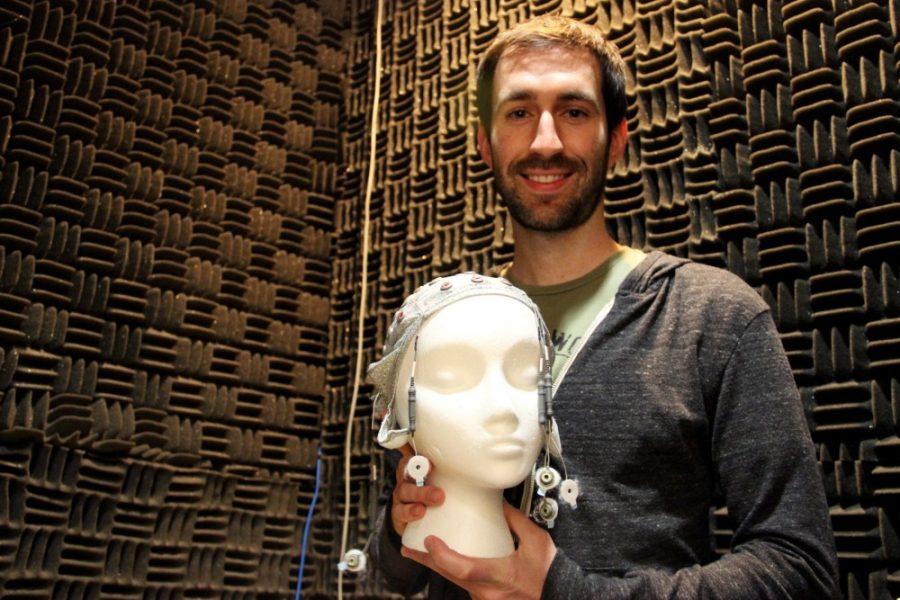Imagine that your friend walks into the room wearing a dark shirt. You turn to look at him and notice something odd on his shoulder: a big tarantula peeking over at you. You instantly warn your friend of the creature’s presence, and the danger is averted.
This situation requires your brain to do some high-level processing of shapes and meaning after a moment’s glance.
Researchers at the UA are trying to figure out what exactly goes on in the brain immediately after visual stimuli are observed.
“The question that we wanted to ask: ‘How does the visual system process the meaning of shapes when you’re not consciously aware of those shapes?’” said Jay Sanguinetti, a graduate student in the Department of Psychology and the first author of the study published in the journal Psychological Science.
The traditional view is that the brain isolates certain objects in the field of view and quickly works to identify and respond to those objects, largely ignoring the things in the background or along the borders of the primary objects.
The study found otherwise through an experiment designed by Sanguinetti.
In the experiment, subjects are told to look at a computer screen that periodically flashes a white shape on a black background for a fraction of a second. The subjects are told to push one button if they recognize the shape — whether it’s a cactus, a bicycle or an ice cream cone — or press another button if it is a “novel shape,” a random shape that doesn’t mean anything to them.
However, what the subjects aren’t told is that many of the novel shapes have hidden shapes along their borders. For example, the subject may be shown a courtesy image in which a novel shape is silhouetted by a meaningful one. The researchers are trying to figure out whether the subjects can perceive objects of which they aren’t consciously aware.
To find that out, Sanguinetti uses electroencephalography equipment to measure the electrical activity in the brain — namely, a spike that occurs 400 milliseconds after the stimulus is shown called N400. Sanguinetti said although it is unclear exactly what N400 represents, previous research seems to show that it’s the “moment in time where the brain is sort of integrating meaning” into its perception of the shape.
Due to a unique feature of the N400 spike, the team can determine whether or not the subjects are unconsciously perceiving the hidden shapes, said John Allen, distinguished professor of psychology, cognitive science, and neuroscience and co-author of the paper.
Allen said that when a meaningful shape is repeated, the spike in brain activity is smaller on the second viewing, which indicates that the brain isn’t working as hard because it recently processed the shape. But when a novel shape is repeated, the N400 signature is the same in both viewings, seemingly because the brain is working equally as hard to process the foreign shape the second or third time it flashes across the screen.
So if N400 is diminished on the second viewing of an unknown shape with a hidden, known shape in its border, the researchers can conclude that the subjects are actually perceiving the silhouetted objects without being aware of it.
After analyzing the data, the team found exactly that — the subjects were unconsciously attaching meaning to the hidden shapes.
That goes against the traditional theory that the brain selects objects based on their borders before trying to recognize what’s inside, said Mary Peterson, a professor of psychology and director of the UA cognitive science program, as well as Sanguinetti’s adviser and a co-author of the paper.
“Our research shows that the brain, whenever it has a border, is attempting to recognize objects on both sides of that border before it decides where the object lies,” Peterson said. “[The brain is also] processing the meaning of those objects.”
Peterson said that although the research probably won’t immediately lead to any practical applications, potential applications include the creation of prostheses for people with brain or eye damage or the development of “machines that see,” she said.
While the research may not have any groundbreaking applications in the near future, Sanguinetti said he appreciates the recognition that he and his team have received after two years of work.
“When you do this type of research, it’s hard to see the light at the end of the tunnel,” he said, “so we’re ecstatic to be getting so much attention, because we put lots and lots of work into this.”









